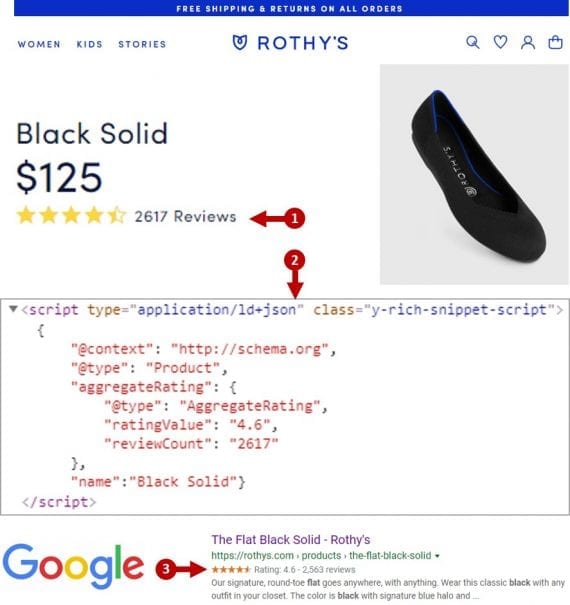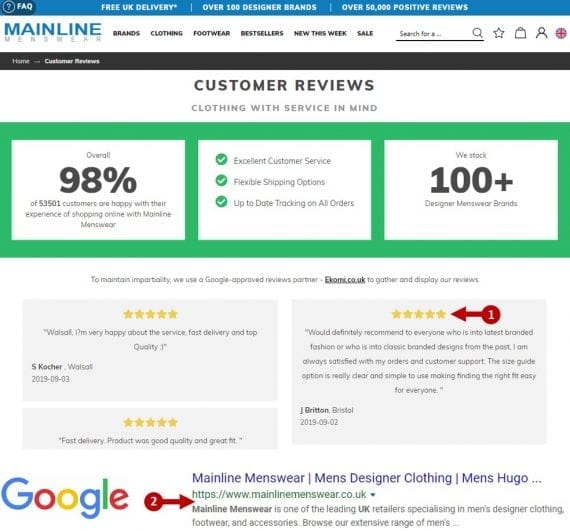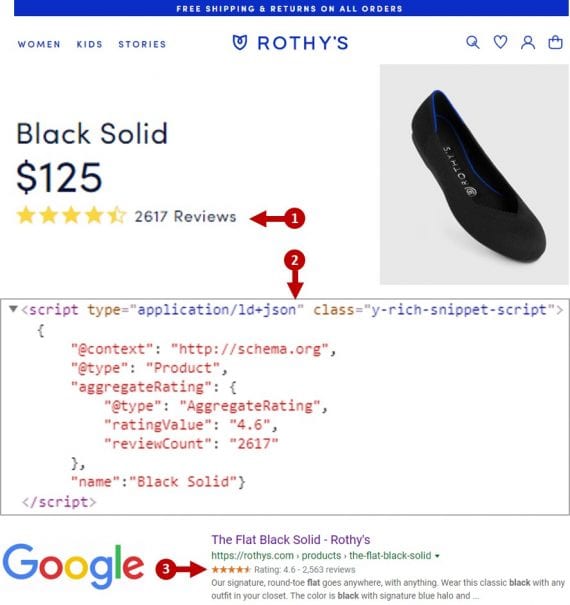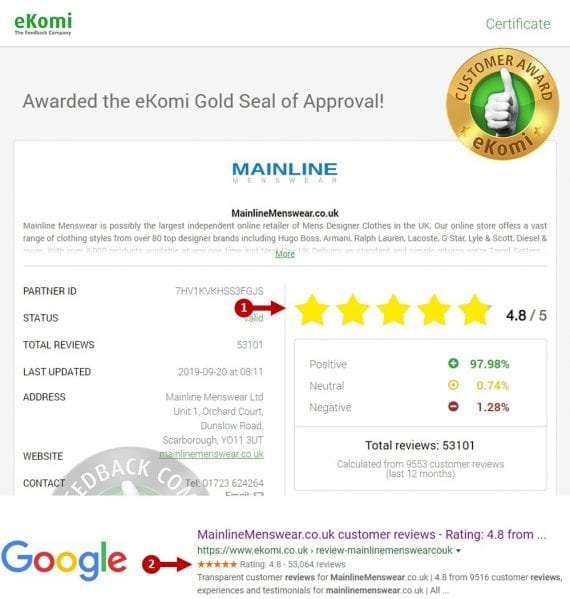With a new algorithm, Google is determined to remove “self-serving” reviews from rich snippets in search results. Thankfully for ecommerce companies, traditional product reviews on product pages shouldn’t be affected.
Google announced guidelines last week on the types of information that can trigger review rich-snippets and how to mark up reviews to qualify. Before I get into the nuts and bolts of the new algorithm, though, let’s review rich snippets and structured data.
Rich Snippets
Rich snippets are the part of organic search listings beyond the standard blue link followed by a couple of lines of descriptive text. Ecommerce sites tend to snare rich snippets for reviews, prices, availability, sitelinks, and breadcrumbs, among other types.
Rich snippets — such as the orange stars for reviews — only appear in an organic search result when the underlying HTML for that page has been marked up with structured data.

Rich snippets only appear in organic search results when the underlying HTML for that page has been marked up with structured data. This rich snippet example is product reviews for a shoe. Click image to enlarge.
For example, in the illustration above the 1 mark shows that the product page for Rothy’s Black Solid, round-toed flats has collected 2,617 reviews that aggregate to 4.6 stars. The 2 identifies an excerpt from the page’s HTML source code, which contains the structured data that makes review data easily consumable for search engine bots. The 3 mark points to how Google displays the information as orange stars and grey text in the review rich-snippet
For search engine optimization, structured data is information in a specific, machine-readable format that follows a standard set forth at Schema.org. This standard delineates types of information that the structured data describes, such as a product, an event, or a recipe.
Structured data similar to the review structured data shown in the image above is responsible for triggering other rich snippets, as well as informing broader search features, such as corporate contacts, how-to panels, and recipe carousels.
Google’s new algorithm of listings eligible to receive review rich-snippets focuses on pages that:
- Use structured data in a qualified schema type;
- Include the name property;
- Contain reviews that aren’t self-serving.
Structured Data Qualifications
The first two requirements above are based on structured data. Only structured data in certain schema types are allowed to trigger review rich-snippets.
Previously, you could attach review markup to any schema type. For instance, you could attach review markup to the Language schema type if you wanted to write, say, a post about your feelings on the English language. Now Google specifies 17 schema types that it will consider generating review rich-snippets for, including Product, Book, LocalBusiness, Recipe, and Organization.
You also need to include the name property in your review structured data to specify the name of the item that’s being reviewed.
Self-serving Reviews
In the most ominous of the three conditions listed above, Google has identified certain types of reviews that it considers “self-serving.” Google will no longer include such reviews in search results as rich snippets.
Google stated: “We call reviews ‘self-serving’ when a review about entity A is placed on the website of entity A — either directly in their markup or via an embedded 3rd party widget.”
Google maintains that the presence of some kinds of reviews using the LocalBusiness and Organization schema types on a site are meant to benefit the company rather than the consumer. Because self-serving reviews are not consumer-centric, Google won’t draw attention to these pages on search results as rich snippets.
For example, posting a page of customer reviews that speaks to the benefits of working with your company overall could potentially qualify as self-serving to Google. However, traditional product reviews on product pages are marked up using the Product schema type — Google presumably wouldn’t consider those reviews to be self-serving.

Mainline Menswear’s testimonial page generate a review rich-snippet on Google’s organic search results. Click image to enlarge.
The illustration above shows a page of reviews for Mainline Menswear. The reviews were pulled in from a third-party vendor that collects and displays reviews on the company’s performance. Google might consider the reviews on this page as self-serving. Even if the stars data indicated by the first mark had been coded using the LocalBusiness or Organization schema type, Google’s algorithm could potentially determine not to display a review rich-snippet on the search result for this page.
To confuse matters even further, a third-party vendor, such as eKomi, that collects reviews about other companies can qualify for the review rich-snippet on a search for the company’s name, as long as it is using the LocalBusiness or Organization schema type.
In the 1 mark on the example above, eKomi’s page aggregates reviews for Mainline Menswear and marks up those reviews with structured data. The 2 mark points to the review rich-snippet Google displays for eKomi’s efforts.
Thus a company itself cannot rank with a review rich-snippet, but another company that aggregates such reviews can. The distinction is that the company hosting the review cannot be the same as the company being reviewed.
Even with these changes, review rich-snippets continue to benefit ecommerce companies. The instant visual appeal of those orange stars makes jumping through Google’s hoops worthwhile. Continue to mark up your product data — especially your product reviews — with structured data in the Product schema type, and your search results will be eligible to display review rich-snippets.
However, ecommerce companies should revisit marking up dedicated pages of reviews that focus on the company as a whole. Otherwise, there’s a good chance that Google will determine those reviews as self-serving and won’t include them in as rich snippets in search results.

